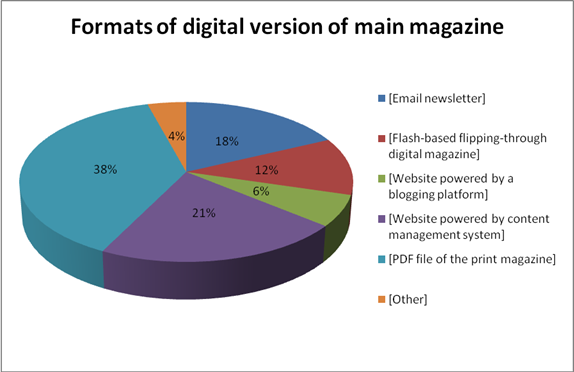Web professionals have always frown upon the use of PDF as the online version of a print newsletter or magazine.
For some publication officers and college magazine editors, PDF is an easy way to provide the online version of their hard print work.
Just take the final file from the designer (PDF has been used for proofs for many years), have it uploaded to the web server and… voila!
According to The State of Print and Electronic Publications in Higher Ed, a survey completed by 198 professionals last year, PDF is the format of choice for the electronic version of the main magazine in 38% of the cases as shown below.
- PDF file of the print magazine: 38%
- Website powered by content management system: 21%
- Email newsletter: 18%
- Flash-based flipping-through digital magazine: 12%
- Website powered by a blogging platform: 6%
- Other: 4%
Even if the practice is quick and cost-effective, it has been proven by many usability studies that PDF isn’t a user-friendly format for people browsing on computers. These files were also problematic for search optimization as their content was not indexed by search engines in the past – but this isn’t the case anymore.
Yet, in web circles, PDF still has a bad vibe. No respectable web professional wants to see PDF used on web servers for anything except maybe for official forms that needs to be printed.
While I still think web versions of print magazines or other publications are a better way to cater to readers using a computer or even a smartphone (or a pocket sized web mobile device like the iPod Touch), I can’t help think it won’t be the case for ebook readers or tablets – especially when these new “reading” devices are going to get a big push from students looking for a better text book solution.
So, what should a college magazine or publication officer do?
Adopt a multichannel approach: develop a real online version and keep the PDF version for print publications – even if they end up not printing them anymore in the future.
What do YOU think?





When we re-launched the Colgate Scene, the university magazine, last year, we decided to do both. http://www.colgate.edu/scene
Why? Well, why not?
Our aim was to build a stand-alone, interactive magazine website but we also wanted folks to have the context of the magazine, since that’s where we start in terms of content development. There is a flow and cadence to a magazine that has to be re-interpreted for the web. Some folks who either get the e-only edition or have ditched (gasp!) their print version may want that in PDF format.
So, I go back to the original point. It’s an easy thing to do on our end and if it improves the experience for even a few readers, why not do it?
Good to hear from you, Charlie!
So, do you think the ebook reader/tablets are going to be a game changer for electronic publications?
I think we might see a new platform, particularly for the new tablet, that incorporates the multimedia offered by HTML with the ease of “turning” pages offered by a PDF. Check out the Sports Illustrated Tablet Demo on Youtube:
http://www.youtube.com/results?search_query=sports+illustrated+tablet+demo&search_type=&aq=5&oq=sports+illustrated+
Yes. In many ways, our move to markup languages in the last 20 years was an expression of need for greater abstraction between data, business logic, and display format. Now having developed the technologies to PRODUCE that sort of workflow, device manufacturers will now give us the tools to CONSUME it in a more refined format. Very little beats a white piece of paper when it comes to artistic/creative/brand expression, so if the devices will allow us all to do it, we will.